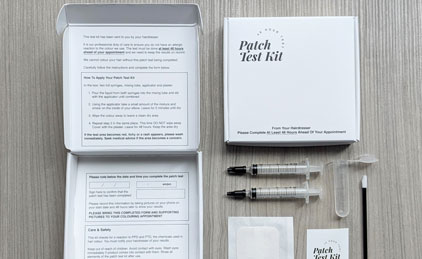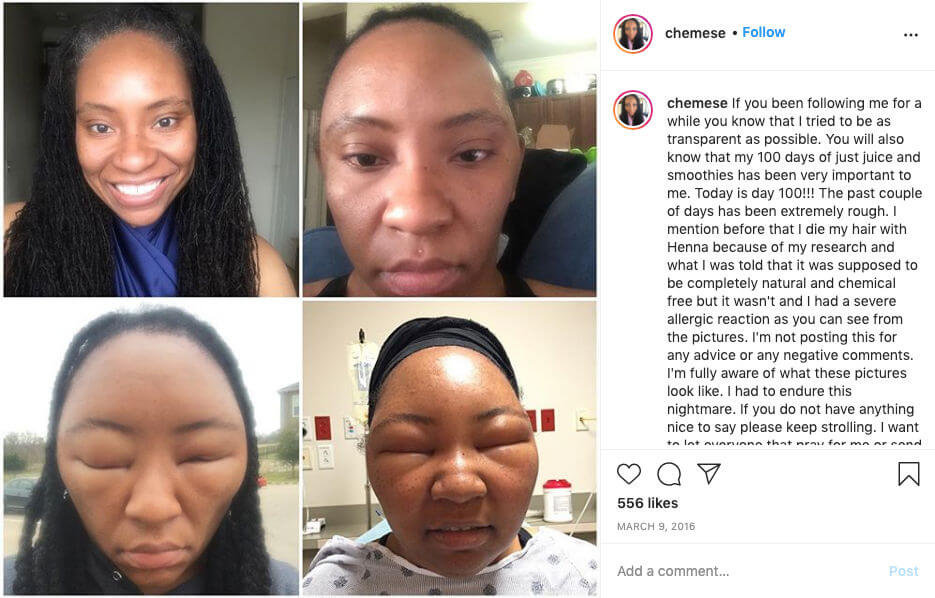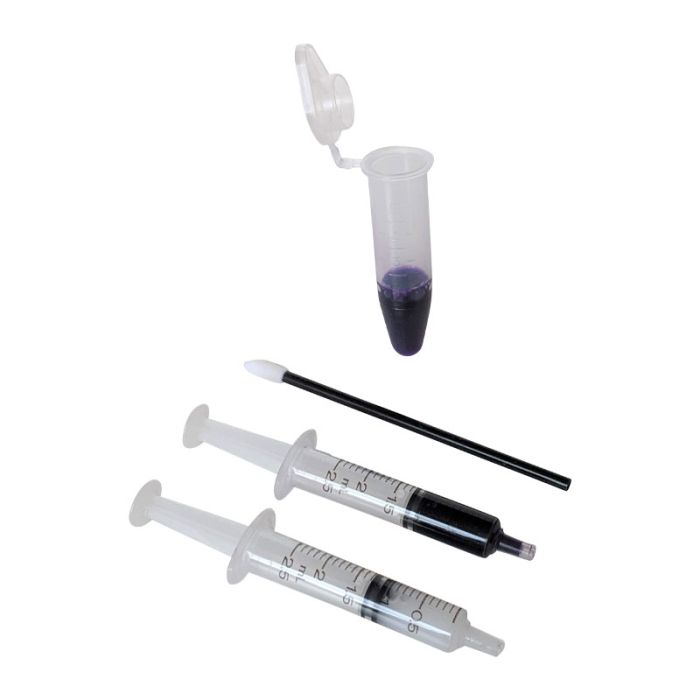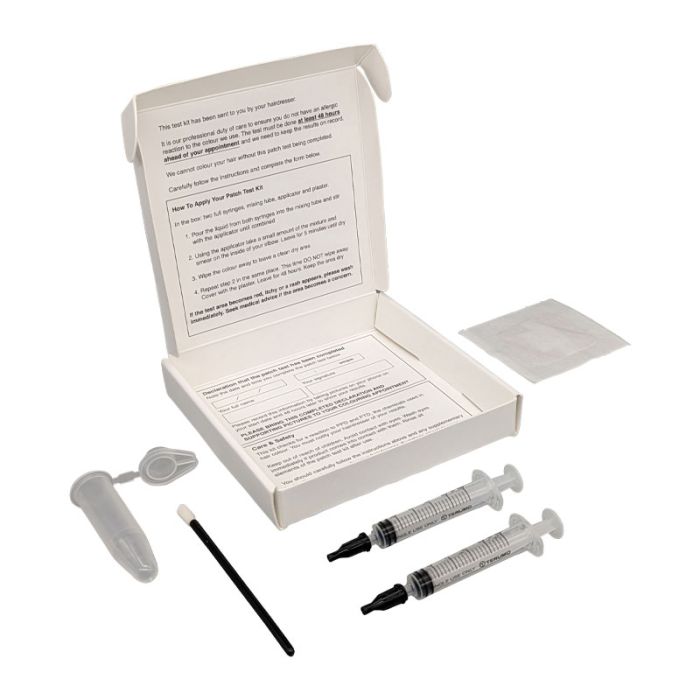
“It is such a simple thing to do, but why do so many salons not understand the importance of patch testing or bother to do it on their clients?” says this article’s guest author, Marie Louise Coster.
There are so many reasons why thorough patch testing is essential in every salon if your client is undergoing a hair colour service or lash and brow tinting. The risks involved with not giving one can be serious; allergic reactions can be catastrophic for your clients, while financially, they can leave you with heavy legal bills, fines and settlements.
So, what exactly do you need to know about patch testing?
What is it, how is it carried out, and what are the reasons behind it?
What is patch testing?
When we are at college, we are taught to patch test a client with the mixed tint and peroxide, prepared just as if it were a treatment, by applying the mixture to either the crook of the elbow or behind the ear 48 hours before.
If the client has a positive reaction, this area will become red, itchy and irritated. If there is a negative reaction, nothing will happen, and it is safe for the treatment to take place. It is not good enough that the client has had the treatment previously elsewhere – they MUST have a patch test with you as your product may be produced by a different manufacturer. It is also important to repeat your patch test regularly, as repeated exposure to a product can eventually develop into an allergy.
You should record all instances a patch test has been given to a client – ask them to sign to show they have agreed to the patch test and keep it on file.
It’s not just hair dye that requires a patch test, though. Patch tests are also needed for treatments such as lash lifts, lash and brow tints, lash perming, perming or even hair removal wax. Always check the advice given by the manufacturer to see if a patch test is required first. If you aren’t sure, carry one out anyway.
When a client books a hair colour service, make sure that you:
- Check that the client is over 16 years of age.
- Your staff should also be aware of the allergy alert testing procedures for over-16s.
- New clients must have an allergy alert test at least 48 hours before their appointment.
- Returning clients will need an allergy alert test if they have not had a test for six months, they’ve had a tattoo or black henna tattoo, or they have changed their colour brand or product in the salon.
What Does Patch Testing Test For?
Patch testing is the safest way to test whether your client is prone to a skin reaction called ‘contact dermatitis’. This is a type of skin sensitivity that can be triggered when the skin comes into direct contact with certain ingredients. It often results in itching, dryness and irritation that can also cause swelling.
One of the most common causes of contact dermatitis is a chemical called paraphenylenediamine (PPD). This is present in many hair dyes. Allergies to PPD can occur even when the client has had no previous reaction to it before, as they can develop over time. A severe allergic reaction to PPD can also result in allergies to other substances that have never been present before.
However, it’s not just dyes containing PPD that you need to patch test for. Some beauticians and stylists assume products labelled as ‘natural’ or ‘organic’ don’t require a patch test. This is incorrect – every dye, tint or chemical that will come into contact with the skin needs to be patch-tested first.
Related: Everything you need to know about PPD in Eyebrow Dyes
A note on black henna tattoos
It’s very important that you ask your client if they’ve had a black henna tattoo since their last allergy alert test. This is because black henna often contains illegally high levels of the chemical PPD (paraphenylenediamine).
Clients who have had black henna tattoos can subsequently become very sensitive to PPD in hair colour – even if it’s a hair colour they’ve had many times before. The NHS has issued warnings about black henna tattoos. One woman died from a serious anaphylactic reaction when colouring her hair after having a black henna tattoo five years earlier.
Why is Patch Testing Important?
Besides the client’s safety, comfort and well-being, patch testing is an insurance requirement and is important for the good name and reputation of your business. If you have a client who does react to a tinting treatment without a patch test having taken place, some insurance companies will class your insurance as invalid and refuse to cover you or payout for any claims made against you.
This will also make it difficult for you to obtain future insurance coverage and will also give you a very poor reputation – after all, clients are much more vocal about the poor treatment and services they have received than they are about the good experiences and a reaction to a tinting treatment is a sure-fire way of ruining your reputation.
Other insurance companies may pay out due to your negligence, as it will be impossible for them to defend your actions – as you know, you should have carried out the patch test. In the case that the insurance company covers you for negligence and settles the claim against you, there is sure to be an increase in your insurance premium.
It is also important to point out that getting a client to sign a disclaimer will also not provide you with any comeback. A solicitor advises me that such a thing will not stand up in court (ultimately, you know you should not be doing it, and you are the professional). Should something go wrong, a client can claim that they were not made entirely aware of what was going on and the implications of not having a patch test.
It isn’t just lash and brow tint that should be patch-tested prior to treatment. It is also essential to patch-test adhesives for eyelash extensions and false lashes and to also patch test any products used in a required treatment on clients who are sensitive or reactive.
Find out more: Should You Strand Test Your Client’s Hair? The Full Guide
How Often Should You Perform a Patch Test?
HABIA (The Hair and Beauty Industry Authority) suggest repeating the patch test prior to every tinting treatment, and other governing bodies suggest every six months. Personally, I patch test all of my clients every time they visit me (once a month), whether they currently have tinting treatments or not, because at least if they ever want to have a tint, we know whether they are allergic or not. This is a simple and effective procedure that works for me.
When a new client calls for the first time requesting a tint, I insist they have a patch test 48 hours before the treatment. I also have this printed on all of my price lists and also on my website so that there can be no confusion and all clients are aware. In the event that a client questions my method of insisting upon a patch test and is not keen on visiting the salon for the test (usually because they have never been made to have a patch test before), I just politely explain it is for their safety and comfort.
In the end, they will appreciate it and respect the thorough procedures of the salon and its high standards. If you are mobile, fit the patch test in at a time that you are in the area and also a time that is convenient to the client, or if you have a receptionist, you could teach them how to carry out the patch test making it more convenient for the client as she can pop in anytime.
If you are worried that you will lose clients (as is an excuse I have heard a couple of times) by insisting upon a patch test, all I can say is I would rather take such precautions and have the peace of mind that my business will not have a poor reputation, than take the risk and stand the chance of losing my business and my reputation overnight all because I didn’t carry out a 2-minute patch test.
How long does a Patch Test take?
The duration of an in-salon patch test can vary depending on several factors, including the specific product being tested and your salon’s policies. However, in general, an in-salon patch test typically takes about 15 to 30 minutes.
How to complete a Patch Test
1. Preparation
Prepare the product that needs to be tested, such as hair colour, brow/ lash tint or other chemical treatment.
2. Patch Application
A small amount of the product is applied to a patch of skin, usually behind the ear or on the inner forearm.
3. Waiting Period
After the patch is applied, your client will need to wait for a specified amount of time. This waiting period allows you to observe your clients’ skin’s reaction to the product.
4. Observation
During the waiting period, you will periodically check the patch to see if your client develops any adverse reactions, such as redness, itching, or irritation.
5. Removal and Assessment
After the designated waiting period (usually around 15-30 minutes), the patch is removed, and the area is assessed for any signs of an allergic reaction.
6. Discussion
If there are no adverse reactions, your client may be cleared for the full treatment or service. If there are any signs of a reaction, you may need to offer a different solution.
What can happen if a Patch Test is not carried out?
Patch testing can be seen as an inconvenience. Maybe a client is pushing to have their hair coloured the next day or doesn’t see the point in making the journey to your salon just for a small task. However, it is always worth insisting on patch testing when you consider the potential consequences.
Lash Tint Allergic Reaction…
These pictures were provided to me by a client of mine who reacted to an eyelash tint. Believe it or not, this occurred whilst she was a student at a local college. Although she had reacted to the patch test, her lecturer said she could have it done anyway, and they would just use the tint and not the peroxide.
The reaction was so bad, and her eyes were so swollen that she could not open them for several weeks, and doctors advised her she may never see again. This is obviously a very serious reaction to the chemicals used, though the reactions can be even worse – some severe cases of allergic reactions to salon products have resulted in death.
Thankfully, the client above is fine now, but you must agree that seeing these pictures makes you realise (if evidence was needed) that a patch test that takes just a few minutes is essential.
Discover: The Importance of Choosing the Right Insurance For Your Beauty Business
Health vlogger shares her story of a severe allergic reaction to henna…
Vegan and fitness blogger Chemese Armstrong from Texas shared her experience of having a severe allergic reaction to henna dye. While Chemese was under the impression her ‘all natural and chemical free’ dye would be perfectly safe, it actually included PPD within the ingredients.
After a few hours, her scalp began itching and burning, while over the course of the next day, her face began to swell so much that her eyes couldn’t open, leading to a rush to the doctors. Despite a shot of adrenaline to ease the pain, the swelling worsened and resulted in a trip to the emergency room.
Thankfully, Chemese’s condition began to improve, though even after a few weeks, her skin was still dry and peeling.

https://www.instagram.com/chemese/
Is Patch Testing a Legal Requirement?
If you are still questioning whether you really need to carry out patch tests on your clients – or are still struggling to convince clients that they do need them – then you should know legal regulations actually cover it.
The Healthy and Safety at Work Act covers a lot of the activities in your salon. While patch testing isn’t specified by name, Section 3 states that the employer is responsible to ‘ensure, as far is reasonably practicable, that persons other than themselves or their employees are not exposed to risks to their health or safety’.
This means that it is your legal obligation to ensure you take every necessary step to keep your clients safe from harm.
If you either deliberately or negligently fail to complete a patch test or carry out a treatment after a patch test reveals a positive reaction, you have failed to protect your client when you should have known a risk was present. You are legally liable for any damage that might result from it – this could result in a fine or even prosecution.
Discover: Which eyebrow beauty treatments are best for your clients?
Reactions to hair colour post-COVID-19
One observation that has emerged from salon owners is an increase in allergic reactions among those who had previously tested positive for COVID-19. While there has been no official research into the effects the disease may have on the immune system long-term or the effect this may have on the development of allergies, it does highlight one undeniable point. Regular patch testing for every hair colour client is vital.
It has always been important for patch tests to be carried out every six months or whenever a new product is introduced. However, with many of us now potentially having weakened immune systems due to COVID-19, keeping on top of your patch tests is more essential than ever.
Each kit contains:
- 1x postal box & sticker to seal the box.
- 1x mixing tube, applicator & hypoallergenic plaster.
- 2x syringes & end caps.
Build the cost into the price of your service, or gain extra profit by retailing these to your client for £9.99.
Fill Syringes
Syringe 1: add 1ml of hair dye.
Syringe 2: add 1ml of developer (if required by your colour manufacturer – please check their instructions).
Firmly replace syringe end caps ready for posting.
Post To Your Client
Notify your client about the kit in advance and post it to them before their appointment.
Seal the box using the sticker provided and post using a large letter postage stamp (stamp not provided).
Remind Your Client
Clients should begin the test at least 48 hours before their appointment.
They should bring to their appointment their signed Patch Test Kit declaration and supporting images to show that the test has been completed.
Retain Evidence
You should retain the signed Patch Test Kit box as proof that the test has been completed.
Top tip: To save space, photograph the signed box and keep images against your customer’s record.
Salon patch testing is an essential safety measure to protect clients from potential allergic reactions and to ensure that the salon can provide treatments that are both effective and safe for each individual. It’s crucial for both the client’s well-being and the reputation of your salon.
Shop Professional Salon Supplies At Salons Direct
Discover the Salons Direct blog, your trusted source for industry news, product releases, how-to guides and more!
You may also enjoy…
The Importance of Client Consultation | The Importance of Hygiene in a Salon | How to Deal With Difficult Clients
Follow Salons Direct on Instagram







So am I to believe that by law they do not have to do a patch test ?
No.. The law is clear.. Patch test is required. The risk is getting sued. If you go before a judge because they reacted to a tint and you didn’t patch test or you had them “sign a waiver” if they refused? The law doesn’t allow refusal or waivers. Either patch test when required or suffer the cost of the reaction by paying medical bills and deal with your State Licensing Board once they are notified of the outcome of the case. You have to get sued for any of this to apply. This is why a lot of stylists disregard the law. They rarely, if ever, get in trouble for it
No not by law, but by insurance yes.
This means you can sue but your chances of getting compensation is rare as the insurance would be invalidated so you would need to bring a private prosecution against the hairdresser. We deal with these cases as expert witnesses in trichology.
I patch test every time a client comes regardless. But I have lost a client because she refused to be tested on her second visit(3 months later), so I refused treatment . But on the up side she tried bad mouthing me and I now have 3 more clients coming BECAUSE I patch test each time and they have never been patch tested at the place they went before. I myself have had a reaction out of the blue to a wax product I have used for years, So now patch test the wax each time too. My clients have said in the past how they appreciate me taking time to protect their well being . Now have a notice up saying we do a patch test each visit for all products used in treatment. The industry needs stronger guild lines so it may mean more paper work and slightly longer consultations but its better than a client injured and your reputation destroyed.
Hi, just wondered if it is safe and will it work if I premix a solution for the secretary to use when someone comes into the salon to book to have a treatment? If the premixed solution is mixed a few days before?
No as the peroxide evaporates. Saying that, a lot of the reaction is due to the paraphenylenediamine in the hair colours and this can be tested for without mixing with peroxide.
It only takes a dot of tint and a couple of drops of peroxide so hopefully a receptionist could do that?
Love it! I agree!
As a Trichologist I’m pleased to read this blog and hope people take note, especially about reaction after an accumulative effect of repeated processes. We deal with too many cases of hairdressing disasters where either patch tests or strand tests have not been performed.
Regards.